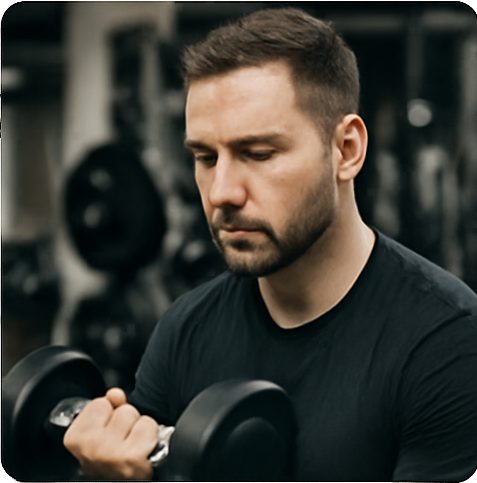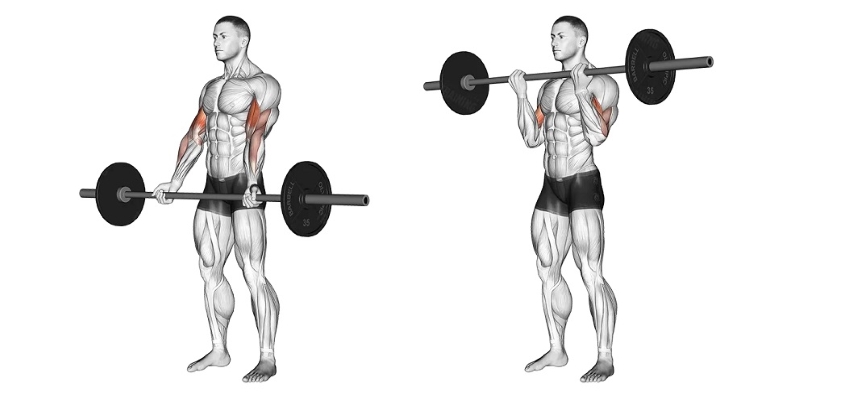I gotta admit, I used to totally sleep on barbell curls. I thought dumbbells were just the better option, you know? They seemed like they gave me more freedom and control. But after giving barbell curls a real shot, I quickly realized why so many people swear by them. The 20kg barbell curl is a popular exercise for strengthening the biceps and improving upper body muscle tone. It actually made a difference for me. My arms started to change, and I could feel the gains happening. It was like I had been missing out this whole time.
How I Got My Barbell Curls Right
How I Actually Do Barbell Curls
When I first started doing barbell curls, my form was trash. I didn’t know I was swinging the barbell around and using my back to help lift. I was cheating myself, big time. The barbell curl is a bicep-focused exercise where you curl a barbell upward towards your chest, engaging the biceps to lift the weight.

But here’s what I learned that finally made a difference:
- Elbows tight: I keep my elbows close to my torso and locked in place. No flaring out.
- No swinging: I stop myself from using momentum. If you’re swinging, you’re not really working your biceps.
- Slow negatives: On the way down, I focus on going slow. That’s where the muscle activation really happens.
Once I nailed this, I started to feel my arms working the way they should. No more shortcuts — just pure focus and control.
Tips and Mistakes That Took My Barbell Curls to the Next Level
Here are some things that helped me really improve my barbell curls, along with the mistakes I made (so you don’t have to):
Mistakes I Made:
- Ego lifting: I used to think more weight meant better results. Turns out, I was just straining my back. Going lighter and focusing on form was a game-changer.
- Leaning back: I’d lean back to get the bar up, thinking it’d help. But all that did was take the focus off my biceps. Now, I lock my core and keep my back straight.
- Breaking my wrists: I didn’t realize how much I was letting my wrists bend. It killed my tension. Keeping them straight and firm keeps that muscle tension on the biceps.
What I Do Now:
- Go lighter: Focusing on control instead of weight gave me way better results.
- Lock in your core: This is crucial. If your core is weak, you’ll end up using your back too much.
- Negative reps: Slowing down the descent of each rep has been a massive help. I can feel it in my biceps every time.
Also, I can’t recommend preacher curls enough. They helped me nail strict form when I was struggling to get my technique right. If you’re serious about perfecting your barbell curls, preacher curls will teach you discipline — something I really needed.
With these tweaks, I was able to take my barbell curls from “meh” to a real strength-builder. If you want to dig deeper, I’ve written a full article comparing Barbell Preacher Curl vs Barbell Curl: What I Learned to break down the differences and why both deserve a spot in your routine.
Muscles I Actually Feel During Barbell Curls
When I do barbell curls, I really feel it in two areas:
- Biceps brachii (the main biceps muscle): I feel the long head of the biceps fire up big time. This is where the bulk of the growth happens.
- Forearms: My forearms also get some work, but not as much as when I’m doing reverse barbell curls. Reverse curls really hit those forearms hard.
Barbell curls are great, but it’s about how they hit your muscles. It’s not just about “what” gets worked, but the intensity and focus that counts.
If you really want to target the forearms more intensely, reverse curls are where it’s at. If you’re curious about why reverse barbell curl biceps workouts hit so hard, I’ve got a full article Why Reverse Barbell Curl Biceps Workouts Hit So Hard that dives into it, and trust me, it’s worth checking out. Reverse curls bring a whole new level of intensity to the table, especially for building up those forearms.
The Gains I Got from Sticking With Barbell Curls
Once I made barbell curls a regular part of my routine, I noticed a few big changes:
- Better strength progression: I started getting stronger. No question.
- Bigger biceps: They weren’t just “prettier” — they were actually getting bigger and more defined.
- A core part of my arm day: Barbell curls are now my go-to. I usually start with them, or at least keep them early in my arm day routine.
They’ve been crucial for building real strength and size in my arms.
Barbell curls aren’t just about getting the weight up. It’s about how you do them and focusing on the small details. If you want more variety in your curls, mix in some reverse barbell curls or preacher curls to keep your arms guessing. But don’t sleep on the basics — get your form right, and the gains will follow.
Why I Still Use Dumbbells But Stick With Barbell Curls Too
I’ve written a full breakdown of Barbell Curl vs Dumbbell Curl: Difference for Biceps Growth before, but here’s the quick version:
- Dumbbells give me more freedom and balance. I can really isolate each arm and get that full range of motion. They’re great for working on imbalances.
- Barbell curls let me go heavier and focus on pure power. There’s something about locking both arms in and pushing the weight up that feels really solid.
So, I don’t just stick to one or the other. I mix them up. Some days I’m feeling like I need more control, so I’ll go for the dumbbells. Other days, I want to push my limits, so I hit those barbell curls. I just alternate depending on how I’m feeling that day.
Are Barbell Curls Still Worth It? Yep, absolutely — as long as you’re keeping your form clean. You can switch things up with variations like reverse curls or preacher curls, but don’t skip the basics — barbell curls still get it done.
FAQs about Barbell Curl
The effectiveness of a 20kg barbell bicep curl depends on your fitness level and goals. For beginners, a 20kg barbell curl is a solid weight that can help build initial strength and muscle endurance. It’s an excellent starting point to develop good form and proper technique. For intermediate lifters, 20kg may be too light to promote significant muscle growth, but it can still be useful for refining form or focusing on higher reps with slower tempos.
For advanced lifters, a 20kg barbell curl might not provide enough resistance for continued progress. To see further gains in strength and size, it is recommended to gradually increase the weight as part of a progressive overload strategy. However, using a 20kg barbell in combination with other exercises and training techniques can still contribute to overall arm development. Always prioritize form over lifting heavier weights to prevent injuries and ensure effective muscle engagement.
Whether a 20kg barbell is enough largely depends on your experience level and strength goals. For beginners, a 20kg barbell is a reasonable weight to start with, allowing for gradual improvement in strength and muscle endurance. It provides an adequate challenge for new lifters while also helping them develop proper technique.
For intermediate lifters, the 20kg barbell may still serve as a part of a workout routine, particularly when combined with other exercises targeting different muscle groups. However, it might not provide the stimulus needed for optimal muscle growth. In such cases, adding weight incrementally or focusing on more advanced training techniques like higher intensity or slower tempos could be beneficial.
For experienced lifters, a 20kg barbell may not be sufficient for progressive strength gains. At this stage, heavier weights and more complex exercises should be incorporated to continue improving strength and muscle mass. The key is to tailor the weight to your current level to maximize the effectiveness of your training.
A 23kg bicep curl can be considered a solid weight for individuals who are looking to progress from beginner to intermediate levels. For beginners, it’s important to focus on perfecting your form before increasing the weight. A 23kg barbell might still be manageable for many, but it could pose a challenge for those just starting out. The key is to ensure you are lifting with proper form to avoid injury and maximize the effectiveness of the curl.
For intermediate lifters, a 23kg bicep curl can be a great way to increase strength and continue building muscle mass. It provides a moderate level of resistance, allowing for progression in the exercise. However, to see continued gains, it is important to vary your workout routine by including different exercises, rep ranges, and tempos.
For more advanced lifters, a 23kg bicep curl may not be sufficient to promote further strength or muscle growth. To continue making gains, incorporating higher weights or alternative exercises targeting the biceps would be necessary.

Hi, I’m the editor here at Leadman Fitness. We’re a manufacturer focused on producing top-quality barbells, plates, kettlebells, dumbbells, and strength training gear. I’ve been into sports and fitness for years, and I know my way around all kinds of gym equipment—both from using it and helping create it.
I spend a lot of time understanding the real problems people run into in the gym—whether it’s beginners trying to pick the right gear or experienced lifters looking for something more durable. I stay in close touch with our production team and talk directly with other equipment makers, so we’re always improving based on what real lifters and coaches are looking for.
What I share comes from hands-on experience—stuff that actually helps people train better, not just in theory, but in real gyms.
